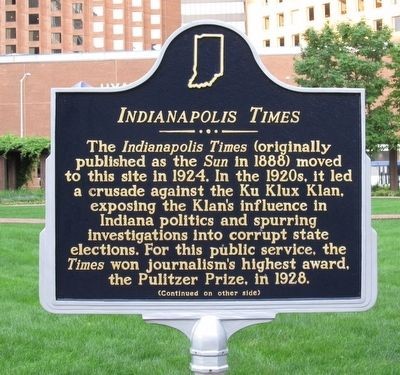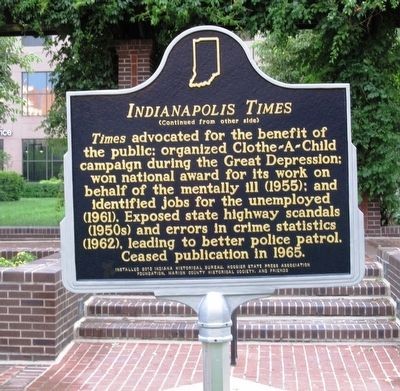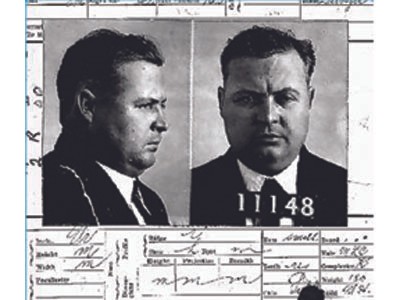Indianapolis Times Historic Marker
Introduction
Text-to-speech Audio
Dedicated in 2013, this historical marker recognizes the importance of The Indianapolis Times newspaper which was established in 1888 as the Indianapolis Sun and was headquartered here starting in 1924. Beginning in 1923, the Times produced a series of articles exposing the Ku Klux Klan, its activities, and the hate organization's political influence in the city of Indianapolis and the state of Indiana. Though it was not the only Indiana paper to publish on the topic, but its coverage was extensive and in 1928, the Times was awarded the Pulitzer Prize for Public Service in Journalism "for its work in exposing political corruption in Indiana, prosecuting the guilty and bringing about a more wholesome state of affairs in civil government," [2]. The newspaper upheld its role in public service by campaigning to aid children during the Great Depression, to help improve conditions and treatment of the mentally ill in the 1950s, and to reduce the city's crime rate in the 1960s through investigative journalism; the paper ceased publication in 1965. As of October 2023, the pole of the historical marker is still located in the west-central portion of Hudnut Commons, but the marker was missing at this time.
Images
Indianapolis Times Historic Marker - Side 1 (image from Historical Marker Database)

Indianapolis Times Historic Marker - Side 2 (image from Historical Marker Database)

Mugshot of David Stephenson (image from East Tennessee State University)

Backstory and Context
Text-to-speech Audio
The Times vs. the Klan, 1923-1928
Though the fraternal organization of the Ku Klux Klan (also known as the Invisible Empire) originated in 1866 in Tennessee and had disappeared by 1877, the group re-emerged in 1915. It grew substantially after the end of the First World War. In the 1920s, the hate organization gained a frightening influence over governments in Texas, Oklahoma, Oregon, and especially Indiana, centering in the capital city of Indianapolis. Led by the Grand Dragon of Indiana, David Curtiss Stephenson, the KKK gained a stronghold in the state's politics [2; 3]. In 1923, the Indianapolis Times began reporting on Klan activities and the fact that Secretary of State Edward Jackson had been exposed as a Klan member by another publication, Tolerance. Jackson, as an open Klansman, ran on the Republican ticket for Indiana governor in 1924 and received campaign support from the organization. The Times detailed the Klan's influence over the Republican platform, including white supremacy, segregation, exclusion of immigrants, and plans to appoint certain government positions exclusively with members of the KKK. The paper openly stood against the control of the government by the organization and committed itself to act against such a takeover. Though Jackson won the election, Grand Dragon Stephenson was tried and convicted of the brutal rape and murder of Madge Oberholtzer the following year. The Times kept its promise, printing a series of articles that exposed the full extent of the corrupt connections between Stephenson, Jackson, and other members of Indiana's government over the next several years. Some of its supporting documents came from the imprisoned Stephenson, who tried to call on his political connections to escape his life sentence, then sold out when they failed to rescue him; aside from his role in getting Jackson elected governor, Stephenson and the Klan had also been involved in corrupt political deals involving Indianapolis' Mayor John Duvall, six city councilmen, and the city administration. Governor Jackson was charged with attempted bribery but got off on a technicality. For its role in exposing the conspiracy, the Indianapolis Times received the 1928 Pulitzer Prize for Public Service in Journalism "for its work in exposing political corruption in Indiana, prosecuting the guilty and bringing about a more wholesome state of affairs in civil government," [2].
Public Service Journalism, 1930-1965
The Times continued in its spirit of public service during the Great Depression, annually campaigning to help clothe Indianapolis children in need beginning in the winter of 1930. The Clothe-A-Child campaign was joined by the Mile of Dimes and continued into the 1950s, raising over $100,000 in 1952 alone. Around the same time, the paper began a series of articles on the condition of mental health hospitals in Indianapolis, advocating for improvements and reforms. These articles earned the newspaper the first Mental Health Bell Award from the Indiana Association of Mental Health in 1955. In 1957, the Times exposed another Indianapolis scandal in the form of shady land-buying deals and embezzlement on the part of the State Highway Department and received the Scripps-Howard National Story of the Month Award for its role in bringing the five culprits involved to justice [1; 2].
During a brief recession from 1960-1961, the Times printed job ads free of charge, listing over 1,700 jobs in a two-week span in April of 1961. The success of the idea led other cities to follow suit, and the Times received yet another award from the International Association of Personnel in Employment Security [1; 2]. In 1962, the newspaper turned its reform-minded eye on the city's rising crime rates with a series of articles called "Streets of Fear." Calling for crime reporting and Police Department reforms, the paper got Mayor Charles Boswell's attention and led to a strengthened police force in Indianapolis. Three years later, the Indianapolis Times closed on October 11, 1965 for financial reasons [2].
Historic Marker Inscription:
The Indianapolis Times (originally published as the Sun in 1888) moved to this site in 1924. In the 1920s, it led a crusade against the Ku Klux Klan, exposing the Klan's influence in Indiana politics and spurring investigations into corrupt state elections. For this public service, the Times won journalism's highest award, the Pulitzer Prize, in 1928. // The Times advocated for the benefit of the public: organized Clothe-A-Child campaign during the Great Depression; won national award for its work on behalf of the mentally ill (1955); and identified jobs for the unemployed (1961). Exposed state highway scandals (1950s) and errors in crime statistics (1962), leading to better police patrol. Ceased publication in 1965. / Erected 2013 by Indiana Historical Bureau, Hoosier State Press Association Foundation, Marion County Historical Society. (Marker Number 49.2013.2.) [1]
Cite This Entry
Marian, Sara and Clio Admin. "Indianapolis Times Historic Marker." Clio: Your Guide to History. October 26, 2023. Accessed March 16, 2025. https://theclio.com/entry/24223
Sources
1. Fehrenbach, Paul. "Indianapolis Times Historic Marker." Historical Marker Database. June 17, 2016. Accessed July 7, 2016. http://www.hmdb.org/marker.asp?marker=95234. 2. Indiana Historical Bureau. "Indianapolis Times." Accessed July 7, 2016. http://www.in.gov/history/markers/4115.htm. 3. Ksander, Yaël. "Klu Klux Klan." Indiana Public Media. February 13, 2006. Accessed July 7, 2016. http://indianapublicmedia.org/momentofindianahistory/ku-klux-klan/.

